In recent years, computer technology has advanced to the point where terabytes of information can be stored remotely and transferred around the world within minutes. Moreover, machines and appliances can utilize computer memory and sensing capabilities to the point where household technology can be interconnected and operated by voice, touch or programming prompts. Now, such technology is set to take over some of the most massive, demanding tasks in the world.
Back in the early 1990s, as most Americans were only hearing about the Internet for the first time, the media declared the Industrial Revolution a thing of the past and the Computer Age the wave of the future. As it turns out, the two are not mutually exclusive, and the revolution never really ended. In fact, the revolution is entering into a new phase, and computers are set to play an active role in the industry of tomorrow.
What Is Industry 4.0?
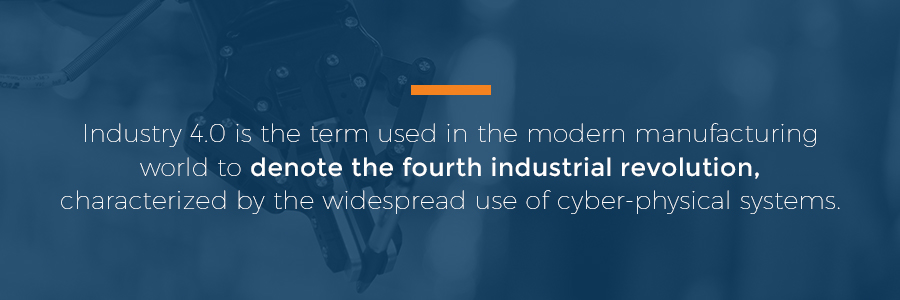
Industry 4.0 is the term used in the modern manufacturing world to denote the fourth industrial revolution, characterized by the widespread use of cyber-physical systems. From a historical angle, Industry 4.0 is the latest phase along the following chain of developments during the last 200 years:
The History of Industry 4.0
https://webpagefx-4.wistia.com/medias/boptanl6fd?embedType=async&videoWidth=800
If you are in the manufacturing world, you may be aware of the more and more commonly used term “Industry 4.0.” What is Industry 4.0 and what is the history behind it?
The history of Industry 4.0 tracks the manufacturing industry from the industrial revolution to the digital transformation and beyond. Each new stage represents a revolution in the manufacturing process that has changed the way we think about and work in the industry.
Industry 1.0 – The Industrial Revolution
It all began with the first industrial revolution, or what most historians refer to as simply “The Industrial Revolution.” This was when the primary means of manufacturing moved from manpower to machine power.
Fuel sources like steam and coal made machine-use more feasible, and the idea of manufacturing with machines quickly spread. Machines allowed faster and easier production, and they made all kinds of new innovations and technologies possible as well.
Industry 2.0 – The Technological Revolution
The first Industrial Revolution represented the period between the 1760s and around 1840. This is where the second industrial revolution picked up. Historians sometimes refer to this as “The Technological Revolution,” where superior electrical technology allowed even greater production and more sophisticated machines.
Industry 3.0 – The Digital Revolution
Although we usually don’t think of the 1950s as the period in which our world became digital, it was here where the digital revolution began with the first computers. These early computers were often very simple, unwieldy and incredibly large relative to the computing power they were able to provide, but they laid the groundwork for a world today that one is hard-pressed to imagine without computer technology.
Industry 4.0 – The Automation Revolution
So we have arrived at Industry 4.0, a term first coined in Germany at the Hannover Trade Fair in 2011 by Bosch. Industry 4.0 is characterized by the level of automation that we have achieved, where machines can often largely govern themselves, in many ways by using internet technologies, or “the Internet of things.” Other features of Industry 4.0 include the use of cloud technology and the importance of big data.
Proponents of Industry 4.0 refer to the concept in terms akin to the smart home — a network of “smart factories,” so to speak. In a smart home, the various luxuries and security features of a modern day residence — lights, appliances, alarms, clocks — are enhanced with digital capabilities, such as sensing, scanning, programming memory and voice and facial recognition. Likewise, Industry 4.0 integrates the following innovations of fourth-generation, computerized technology into the factory setting:
- Cyber-physical system — a mechanical device that is run by computer-based algorithms.
- The Internet of things (IoT) — interconnected networks of machine devices and vehicles embedded with computerized sensing, scanning and monitoring capabilities.
- Cloud computing — offsite network hosting and data backup.
- Cognitive computing — technological platforms that employ artificial intelligence.
The term derives from the German Industrie 4.0, which picked up usage at the 2011 Hannover Fair. The following year, an industrialist collective known as the Working Group presented the concept to the German government. Since that time, the term has spread around the world as companies throughout the manufacturing sector consider the potential for cognitive, interconnected cyber systems in a factory setting.
What Is Needed for an Industry 4.0 Factory or System?
Conceptually, Industry 4.0 consists of the following four design principles, which companies are encouraged to implement to fully harness the capabilities of current technology:
- Interoperability — the integration of industrial machines, tools and vehicles into a computerized IoT framework.
- Information transparency — the ability of sensor-equipped computer systems to make virtual copies of real-world machines and objects.
- Technical assistance — computerized machinery equipped with artificial intelligence to assist human workers with decision making and physical work.
- Decentralized decisions — the ability of computerized systems to act and complete tasks on their own.
Critics of the Industry 4.0 term and concept argue that advances in technology since the dawn of industry have always been gradual. Moreover, critics allege that the current notion of revolution implies that technological innovations have only recently emerged from a static period, which is not the case.
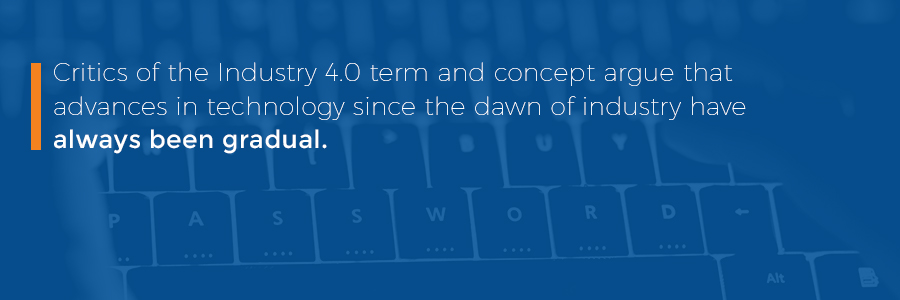
Fact is, technological developments have always been incremental, and the past revolutions typically played out over periods of several decades. That said, this fourth revolution marks the first time that digital, cyber technology has integrated into all levels of manufacturing, to the point where high-tech, cognitive machinery automate intellectual, in addition to physical, tasks.
Proponents of Industry 4.0 counter that the newfound industrial integration of cyber-technology allows for unprecedented autonomy of computerized machinery. When fully applied on all levels, Industry 4.0 creates autonomous factory networks that can implement physical tasks and instantly correct imperfections without the involvement of human hands or minds.
Some of the more ambitious visionaries behind Industry 4.0 assert that the concept will make it possible for productions to network on a global scale. In other words, the geographical boundaries between factory locations will cease to exist in the virtual sense, because the IoT infrastructures of all factories will connect via cloud computing and artificial intelligence.
Despite the vast potential of Industry 4.0 in the realm of manufacturing, numerous obstacles stand in the way of full, universal implementation at present, namely:
- Reliability issues with machine-to-machine (M2) communication, which hasn’t fully arrived at the levels of performance and stability envisioned by Industry 4.0 proponents.
- IT security concerns, which become even more pressing as older, long-unused facilities are brought into the fold.
- Fear of IT glitches — until artificial intelligence has long proven itself across vast IoT infrastructures, the possibility of costly mishaps leaves many manufacturers skeptical.
- Insufficient skill-sets for the implementation of Industry 4.0 among factory engineers.
- Fear that Industry 4.0, once fully implemented, could spark mass layoffs across the industrial sector, leaving many low-educated factory workers jobless.
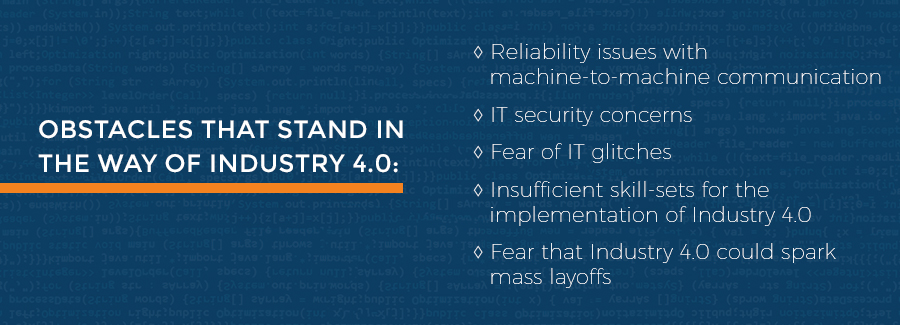
In the years ahead, advancing detection capabilities in cyber-physical technology are expected to virtually eliminate the risk of defects and thereby bring more Industry 4.0 participants on board throughout the industrial sector. Already, many proponents would argue that cyber-systems are much more reliable than conventional, manually operated systems at producing uniform results with exact precision.
In the minds of many manufacturers, the advantages of Industry 4.0 could easily outweigh the risks if you take the physical possibilities of cyber systems into account. IoT and cognitive computing could be used to lift heavy pieces of machinery and vehicles, and thus relieve human workers of the more strenuous aspects of industrial work. As a result of these changes, factories could ultimately see a near elimination of work-related injuries and deaths.
Likewise, computerized machinery could also be equipped to handle some of the workloads that involve high temperatures and toxic chemicals, thus sparing humans from harmful exposure. In effect, Industry 4.0 wouldn’t replace human workers so much as take on the kinds of jobs that most humans find undesirable.

Meanwhile, job training could turn toward the maintenance and supervision of cyber systems, an area that will likely see an increased demand for skilled workers. In preparation for the next revolution, new modes of human/computer interaction could ultimately develop.
Cyber systems and cognitive computing could also lead to higher levels of consistency in production, as technology removes the factor of human error from tasks along the production line. This change could lead to more consistent lines of excellent products from companies across the manufacturing sector. The benefits here will be exponential as businesses enjoy improved reputations for quality, and customers become ever more loyal and willing to buy.
The technological capabilities of the Industry 4.0 model could give a leg up to emerging markets within the manufacturing sphere, such as India, where production arsenals could catapult from primitive to advanced in the span of a few years as more companies in that region implement the model. For upstart manufacturers, the new model could be a quick ticket into the big league. By contrast, companies that are slower and reluctant to change could ultimately be overtaken by their competition.
Meanwhile, the United States is warming fast to the concept of Industry 4.0. One city that has positioned itself as a trailblazer in this fourth industrial revolution is Cincinnati, Ohio, which has named itself a “demonstration city” for Industry 4.0. The Midwest could ultimately prove to be an epicenter of this fourth industrial revolution as manufacturers across the rust belt see the potential in cyber systems, IoT devices and cognitive computing. While some U.S. manufactures fear job losses, technology has also contributed to a 40 percent increase in the productivity of the U.S. manufacturing sector over the last 20 years.
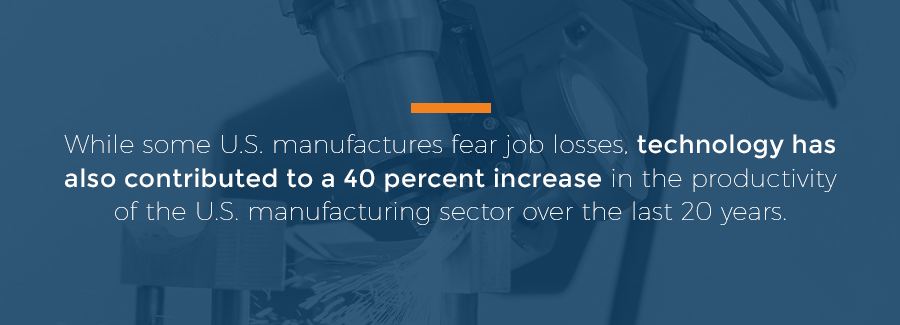
Benefits of Industry 4.0 in Manufacturing
The principles of Industry 4.0 — interoperability, information transparency, actionable insights, automation — could benefit companies throughout the manufacturing sector. As long as businesses implement these tenets competently and wholeheartedly, the Industry 4.0 model could improve the scalability, security, visibility, customer relations, customization capabilities and innovation capacity of manufacturing companies throughout the world. The benefits of the model break down as follows:
#1. Scalability
The automation principle of Industry 4.0 could help to facilitate improved scalability among companies in the manufacturing sector. With automation, manufacturers will have a newfound ability to transfer staff to different departments, away from the physically dangerous areas of production. Automation will also allow for faster production, which will, in turn, equip companies to compete more on the global stage.
Automation will also make it easier for manufacturers to focus on their strengths and hand over other jobs to artificial intelligence. Cloud technology will be at the heart of these developments since it will allow companies to ease up on IT operations. This will be especially advantageous to smaller companies with limited IT resources. Rather than have software and hardware networks managed and maintained with on-site staff, networking infrastructures will instead run remotely via third-party cloud servers.
#2. Security
One of the foremost concerns about Industry 4.0 among manufacturers is the possibility of mishaps due to glitches in cognitive computing. Along this line of thought, some companies are also concerned that cyber-physical systems in an industrial setting will undermine the integrity of the production process.
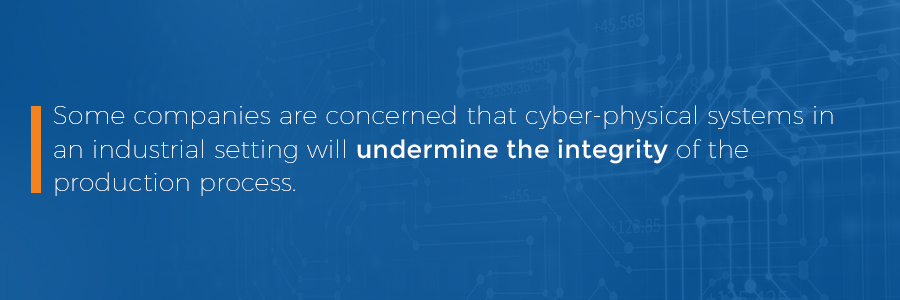
Cloud technology will play a vital role in minimizing these fears by maximizing the security strengths of Industry 4.0. As the cyber-physical and cognitive capabilities of IoT improve, management of these networks will occur via cloud computing. Once all of this goes into effect, companies will no longer have to focus their internal resources on the maintenance of database software and the backup of system files, because the completion of such tasks will take place on the server end.
#3. Control and Visibility
As manufacturing networks globalize, it is crucial to make digital processes visible to all points of a system. When fully implemented, the principles of Industry 4.0 support responsiveness by making information available worldwide within a fraction of a second. They also help to improve collaboration by connecting factories and personnel across different regions via cloud servers.
The vastly improved communication capabilities of the Industry 4.0 framework will also make it much easier to streamline compliance requirements. Essentially, Industry 4.0 allows for enhanced visibility across all links in the manufacturing process.
#4. Customer Satisfaction
When fully applied, Industry 4.0 could be a boon for customer relations among companies in the manufacturing sector. The omni-channel capabilities of IoT cyber systems will allow companies to communicate with customers along every step of the way, from the fulfillment of orders to the delivery of finished products.
By the same token, Industry 4.0 will aid in the ability of manufacturers to collaborate with suppliers and customers alike. The process will be fully transparent along all stops on the manufacturing chain, from the moment someone places an order or submits a design until the moment when shipments arrive. Industry 4.0 will facilitate co-creation capabilities between manufacturers and related entities on a global scale.
#5. Customization
Industry 4.0 could take customization to new levels with the use of commercial 3-D printers, which there are 23,000 of in use worldwide. This technology allows for faster production of newly designed items and allows you to produce items quickly on a smaller scale, which enhances customization capabilities. If you need a new part for a pre-existing product, for instance, you can enter the designs into the system, and the printer will produce the part automatically. This process takes only a fraction of the time that it would take to manufacture the component manually.
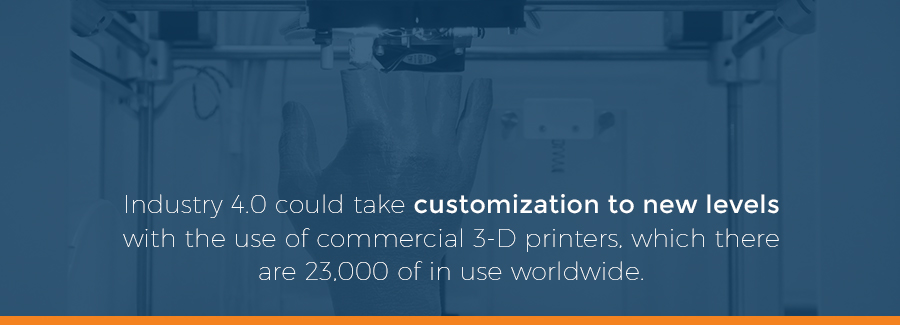
When it comes to the repair and correction of faulty designs, cognitive computing could handle the necessary modifications. It could quickly produce the improved parts and products without the manual labor required in earlier manufacturing setups. Moreover, such products could prove to be stronger and last longer, which could ultimately lead to increased profits.
How to Prepare for It and Things to Consider
For manufacturing companies, the main stumbling block towards implementing Industry 4.0 sooner rather than later is the redirection of internal resources away from IT and toward the adoption of innovative cyber systems.
Granted, the implementation of an IoT framework across any sizeable industrial setting would require advanced skill sets, the likes of which are rare in the industry. Some manufacturing companies have long been content with their arsenals and the innovations that have slowly emerged over the decades. The sudden change from a human-powered to a mostly computer-run infrastructure is a tall order for the typical manufacturer.
The most crucial step toward implementing Industry 4.0 involves the integration of pre-existing business systems such as the following:
- Computer Aided Drafting (CAD)
- Computer Aided Manufacturing (CAM)
- Enterprise Resource Planning (ERP)
- Manufacturing Execution Systems (MES)
- Product Lifecycle Management (PLM)
Ideally, the manufacturers that seek to make the transition in the immediate future should focus internal resources on the innovations required for the change. However, manufacturers currently encumbered with successive IT cycles are liable to lag in the transition, as funds are primarily spent maintaining current systems. While this maintenance might seem necessary, forecasters predict that this could leave the manufacturers that adopt slowly at a competitive disadvantage in the long run.
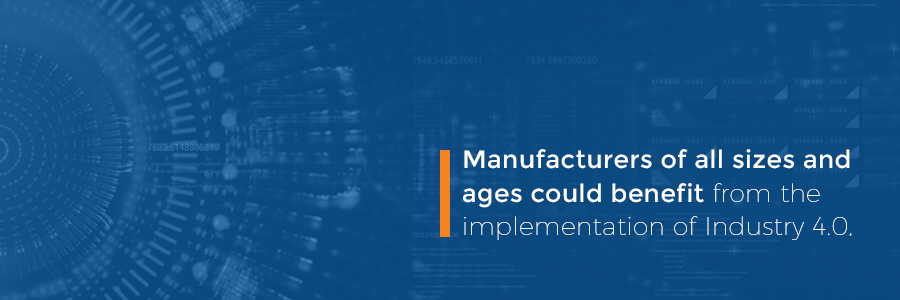
Manufacturers of all sizes and ages could benefit from the implementation of Industry 4.0, which could ultimately prove to be a game changer as underdogs adopt and soar to the front of the pack, and established companies lag and struggle to stay relevant. Over the next decade, Industry 4.0 might turn little-known companies into the new industry leaders.
What Is Industry 5.0?
Less than a decade has passed since talk of Industry 4.0 first surfaced in manufacturing circles, yet visionaries are already forecasting the next revolution — Industry 5.0. If the current revolution emphasizes the transformation of factories into IoT-enabled smart facilities that utilize cognitive computing and interconnect via cloud servers, Industry 5.0 is set to focus on the return of human hands and minds into the industrial framework.
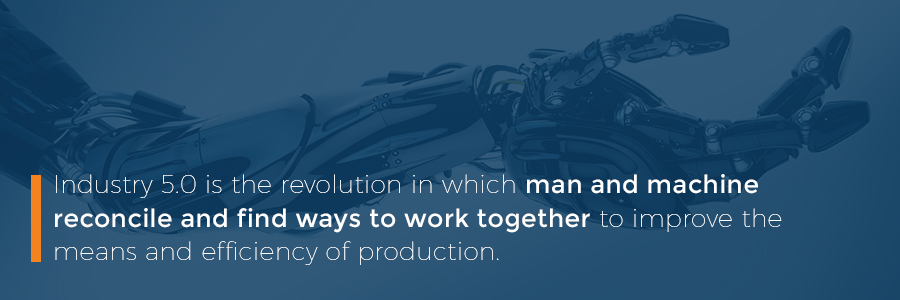
Industry 5.0 is the revolution in which man and machine reconcile and find ways to work together to improve the means and efficiency of production. Funny enough, the fifth revolution could already be underway among the companies that are just now adopting the principles of Industry 4.0. Even when manufacturers start using advanced technologies, they are not instantly firing vast swaths of their workforces and becoming entirely computerized.
In a sense, the concept of Industry 5.0 could ease some of the apprehensions that some manufacturers have voiced regarding the current revolution. Namely, that cognitive computing and cyber-machinery will eliminate the need for human hands and put millions of people out of work. To the contrary, Industry 4.0 could end up restructuring human tasks in the realm of manufacturing in ways that benefit the workers. Humans might become more likely to handle the lighter work while machines take care of the more strenuous.
The greatest advances predicted of Industry 5.0 involve the interaction of human intelligence and cognitive computing. Combined, humans and computerized machinery are expected to take manufacturing to new levels of speed and perfection. The fifth revolution could also prove more advantageous to the environment, as companies develop systems that run on renewable energy and eliminate waste.
Overall, the developments of Industry 5.0 could prove to be the full realization of what the architects of Industry 4.0 had only dreamt of at the dawn of the 2010s. As artificial intelligence improves and factory robots assume more human-like capabilities, the interaction between computers, robots and human workers will ultimately become more meaningful and mutually enlightening. And what could be healthier for the industrial environment than positive working relationships?
Industry 4.0 Today, Industry 5.0 Tomorrow
As technological innovations become ever more rapid, revolutions could ultimately follow one another in quick succession over the next 10 years and beyond. Whereas the first three industrial revolutions took decades to play out, today’s revolutions last only as long as it takes for industry-wide implementation to complete itself. Noting the speed of these developments, it is only natural that talk of a fifth revolution would quickly follow the fourth.

No matter how quickly or slowly some companies implement the Industry 4.0 model, the principles will no doubt shape the manufacturing world of the future. As more companies come on board, some will see exponential growth thanks to the capabilities provided by IoT devices, cyber systems and cognitive computing. In a few year’s time, human workers and factory robots could end up collaborating on designs and sharing workloads across a variety of manufacturing processes.
As one of the foremost names in the repair and servicing of industrial equipment, Global Electronic Services has always been on top of the latest news and trends in the realm of manufacturing. To stay abreast of the issues that impact the mfg sector, subscribe to our blog or follow us on social media.
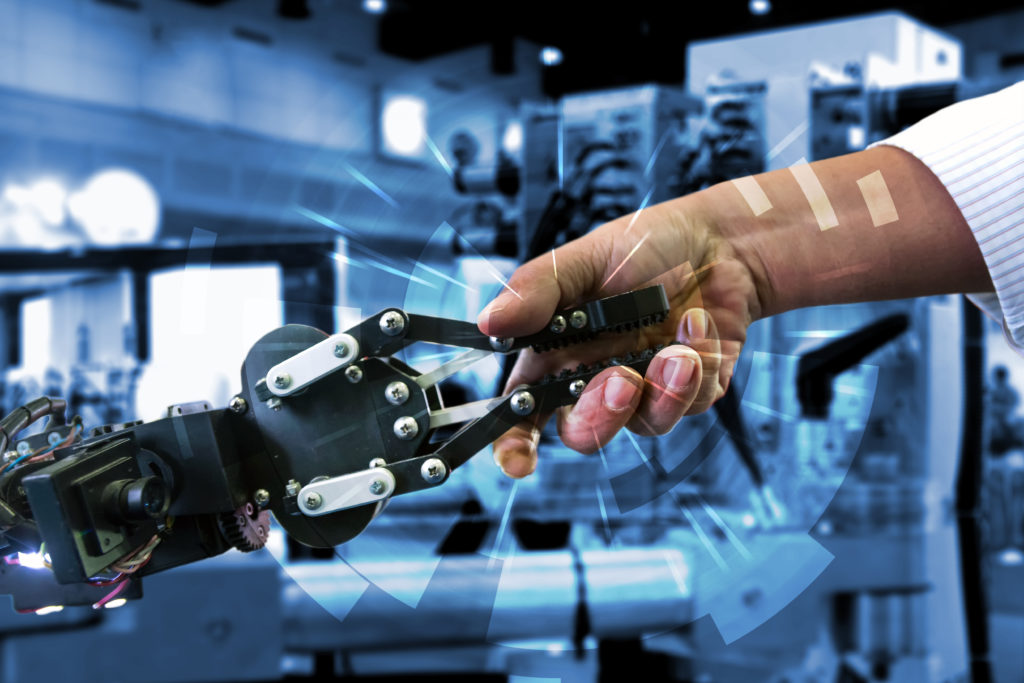
Thank you for great article. I am happy it does more than just touching the INDUSTRY 5.0 surface. As father of INDUSTRY 5.0 I was first to name its principles on December 1st 2015 and I do continue the development in real business environment of interested i dustrial clients sites and factories. If you would like to know more, let me k ow please.
Wonderful document. Its informative and precise.
good
The thoughts given by Industry 5.0 is really appreciable in a critical manner
I have been reading your posts regularly. I need to say that you are doing a fantastic job. Please keep up the great work.